Non-Small Cell Lung Cancer(NSCLC): Treatment Approaches by Disease Stage- Market Insights, Clinical Trials, Product Analysis, Patent Analysis, Competitive Analysis and Market Forecast – 2023-2033
Non-small Cell Lung Cancer (NSCLC) is a prevalent form of lung cancer characterized by the abnormal growth and multiplication of cells within the lung tissues. It represents one of the two primary types of lung cancer, with the other being small cell lung cancer. NSCLC is known for larger cancer cells, and while it typically grows more slowly than small cell lung cancer, early detection is critical due to its propensity to spread.
There are three primary subtypes of NSCLC, each with distinct characteristics:
Additional, less common subtypes include Sarcomatoid carcinoma and Adenosquamous carcinoma.
NSCLC accounts for approximately 85% of all lung cancer cases.
Symptoms may include persistent cough, shortness of breath, chest pain, weight loss, and fatigue. Early detection is challenging, often leading to diagnosis at advanced stages.
Risk factors for NSCLC include smoking, asbestos exposure, metal and mineral dust exposure, radon exposure, chronic obstructive pulmonary disease (COPD), air pollution, pulmonary fibrosis, HIV/AIDS, and previous chest radiation therapy.
Diagnosis involves various tests, including laboratory tests, chest X-rays, CT scans, biopsies, and bronchoscopy. Staging determines the extent of cancer spread, ranging from Stage 0 (localized) to Stage IV (metastatic).
Treatment for non-small cell lung cancer (NSCLC) is multifaceted and depends on factors such as the stage of cancer, the overall health of the patient, and specific characteristics of the tumor
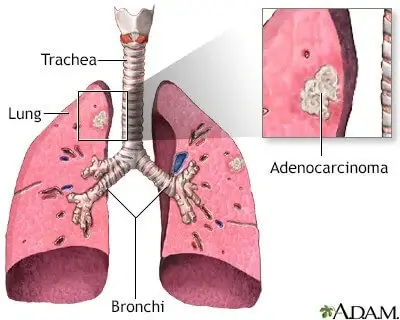
Figure 1 Adenocarcinoma.
Credit (https://www.mountsinai.org/health-library/diseases-conditions/lung-cancer-small-cell)
To gain a comprehensive understanding of the evolving landscape in Non-Small Cell Lung Cancer (NSCLC) research and development, it is essential to delve into the current state of scientific investigation and the emergence of innovative treatment strategies. This knowledge acts as a crucial guide for making well-informed decisions in the NSCLC therapy arena, ensuring strategic choices and the effective incorporation of treatments within the evolving healthcare landscape.
Market Landscape: Non-Small Cell Lung Cancer (NSCLC): Example Illustration: Distribution by Pipeline Candidates
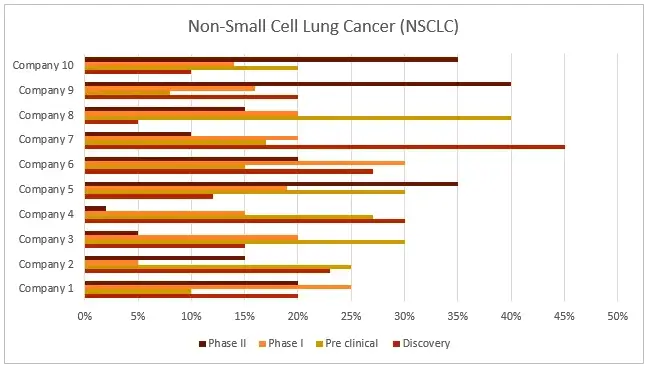
In the realm of Non-Small Cell Lung Cancer (NSCLC) research and market analysis, company profiling holds significant importance. It involves a comprehensive exploration of companies engaged in the NSCLC sector, providing a detailed perspective on a company’s historical context, range of products, financial strength, competitive tactics, and recent milestones. This insightful information assists in assessing the competitive landscape within the NSCLC market and identifying potential prospects for collaboration and strategic partnerships that can foster advancements and innovation in the field.
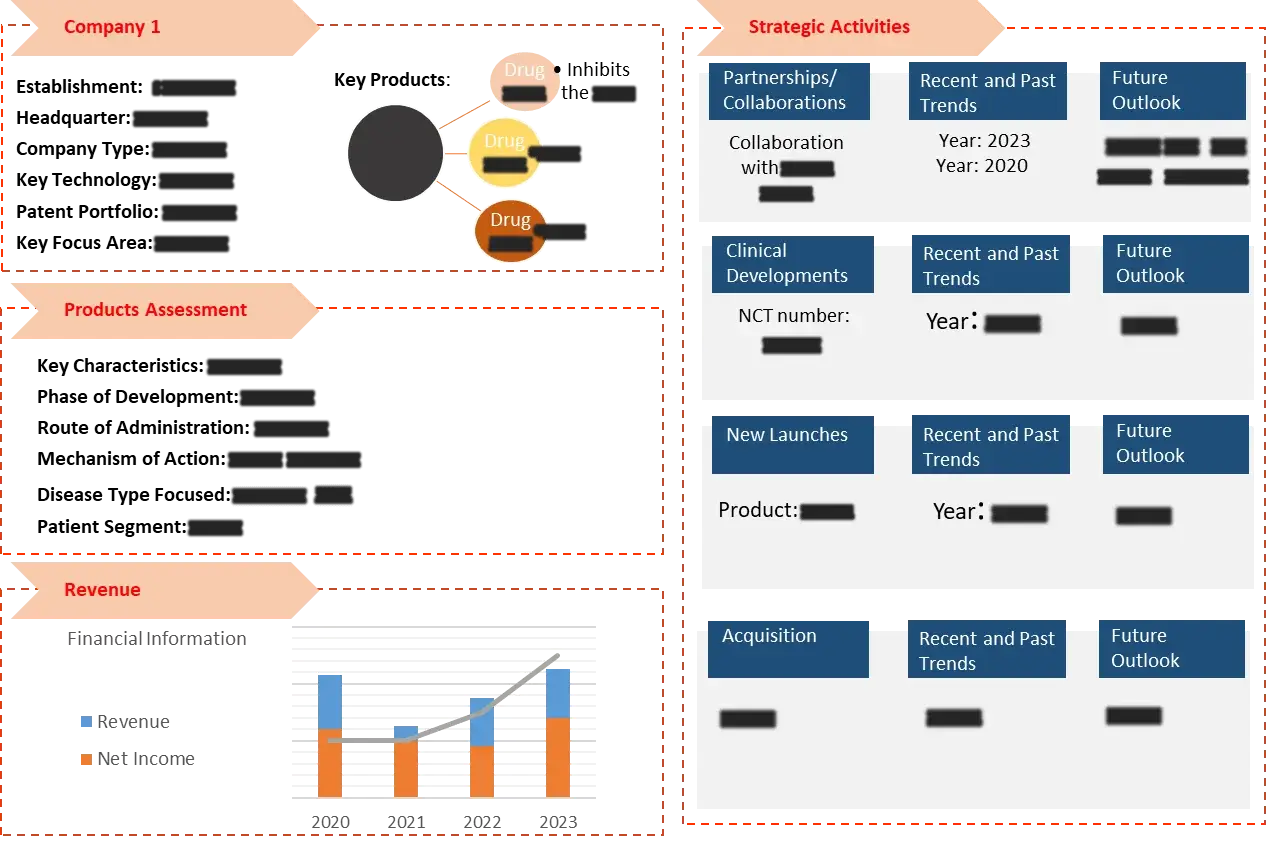
In this report, an in-depth patent analysis will be carried out to extensively assess the intellectual property landscape within the Non-Small Cell Lung Cancer (NSCLC) domain. The analysis aims to uncover notable patents, influential inventors, and emerging technological trends unique to the NSCLC sector. Additionally, it offers organizations valuable insights into the realms of innovation, competition, and potential prospects for enhancing products or engaging in collaborative ventures within the NSCLC field.

Figure 3 Legal status breakdown of the technology field

Figure 4 Geographic coverage of where patent applications have been filed
The clinical trial analysis segment in a market research report provides an extensive assessment of clinical trials pertaining to Non-Small Cell Lung Cancer (NSCLC). This involves a detailed breakdown of trial categories, study structures, research methods, and participant characteristics. Its primary objective is to evaluate the efficacy, safety, and outcomes of pharmaceuticals and medical interventions in the context of NSCLC.
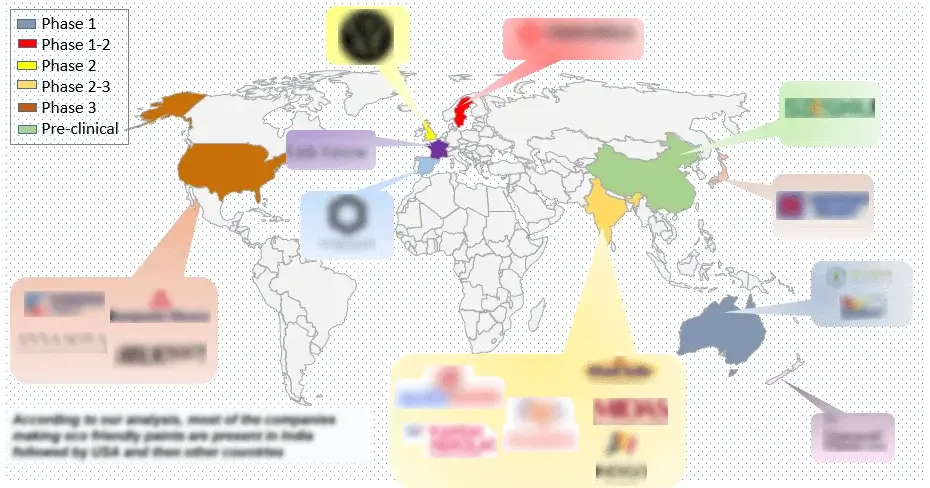
Figure 5 Distribution by Key Geographical Areas
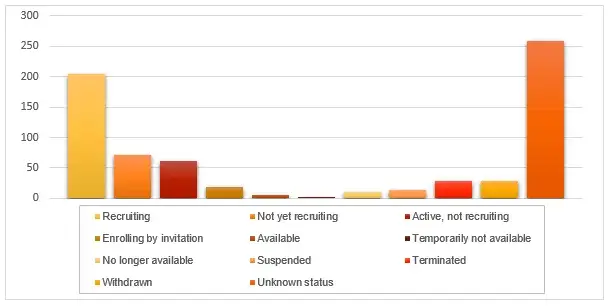
Figure 6 Distribution of NSCLC Drug Clinical Trials by Status
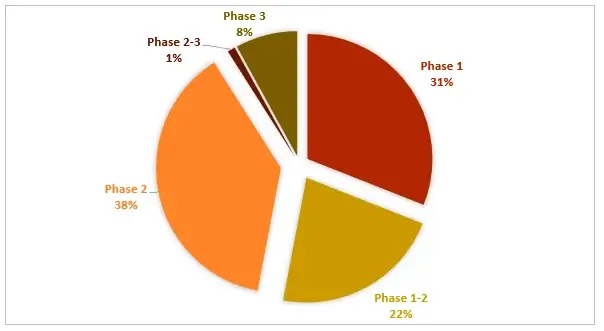
Figure 7 Distribution of Clinical Trials by Phase of Development
In this market research report focused on Non-Small Cell Lung Cancer (NSCLC), the market forecast section offers a comprehensive perspective on upcoming market trends, growth opportunities, and the pivotal factors that affect supply and demand dynamics. This segment includes quantitative predictions and provides valuable insights into market size, revenue forecasts, and potential avenues for growth within the NSCLC field.
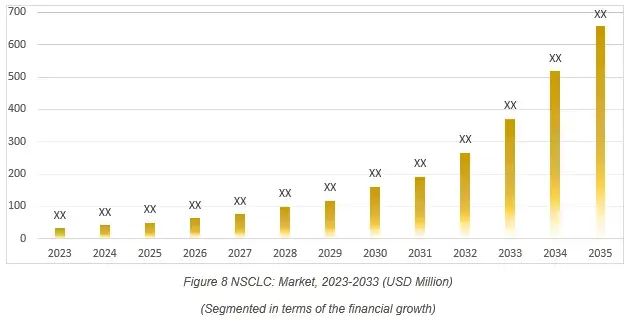
In this market research report centered on Non-Small Cell Lung Cancer (NSCLC), the competitive landscape section will deliver a concise overview of key market participants, their individual market shares, and furnish succinct profiles detailing their strengths, weaknesses, and strategic approaches within the NSCLC domain.
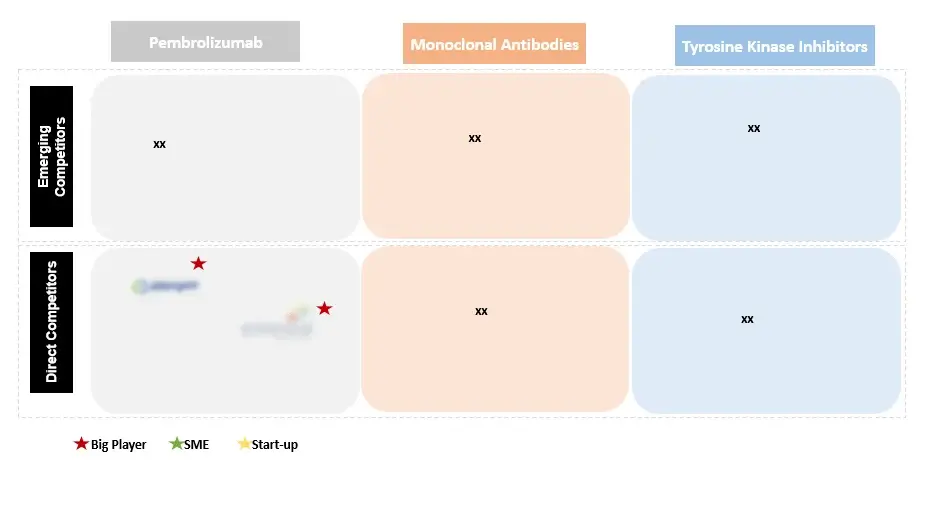
In order to give the most precise estimations and forecasts, Wissen Research uses an extensive and iterative research approach that is focused on reducing deviation. The company blends top-down and bottom-up methodologies for market segmentation and quantitative estimation. In addition, data triangulation, which examines the market from three separate angles, is a recurrent topic present in all of our research studies. Important components of the approach used for all of our studies include the following:
Preliminary data mining
On a wide scale, unprocessed market data is collected. Continuous data filtering makes sure that only verified and authenticated sources are taken into account. Additionally, data is extracted from a wide range of reports in our repository and from a number of reputable premium databases. We gather information from raw material suppliers, distributors, and purchasers to help with this since understanding the entire value chain is crucial for a thorough understanding of the market.
Surveys, technical symposia, and trade magazines are used to gather information on technical concerns and trends. Technical information focusing on white space and freedom of movement is also obtained from an intellectual property standpoint. Additionally, information on the industry’s drivers, constraints, and pricing patterns is obtained. As a result, a variety of original data are included in the material that is then cross-validated and certified with published sources.
Statistical model
We use simulation models to generate our market projections and estimates. Every study receives a special model that is tailored to it. Data for market dynamics, the technology environment, application development, and pricing patterns are gathered and supplied into the model all at once for analysis. The relative relevance of these factors is investigated, and their impact on the forecast period is assessed, using correlation, regression, and time series analysis. The process of market forecasting combines technological analysis with economic strategies, practical business acumen, and subject expertise.
Econometric models are frequently used for short-term forecasting, but technology market models are typically employed for long-term forecasting. These are based on a confluence of the business environment, regulatory environment, economic projection, and technical landscape. In order to develop global estimates, it is preferable to estimate markets from the bottom up by integrating data from key regional markets. This is required to ensure accuracy and a complete comprehension of the subject. Among the variables taken into account for forecasting are:
Regulations and anticipated developments
We give these criteria weights and use weighted average analysis to assess their market influence in order to calculate the anticipated market growth rate.
Primary research | Secondary research |
· Manufacturers · Technology distributors and wholesalers · End-user surveys · Consumer surveys | · Company reports and publications · Government publications · Independent investigations · Economic and demographic data · Online searches · Research reviews · Reference customers |
1. Introduction
1.1 Definition of Non-Small Cell Lung Cancer (NSCLC)
1.2 Significance of NSCLC Research and Analysis
2. NSCLC Overview and Classification
2.1 NSCLC Types and Subtypes
2.2 Disease Progression and Staging
2.3 Diagnostic Methods and Biomarkers
3. Market Insight
3.1 Current NSCLC Treatment Landscape
3.2 Market Trends and Dynamics
3.3 Key Market Drivers and Challenges
4. Clinical Trials in NSCLC
4.1 Ongoing Clinical Trials
4.2 Promising Therapeutic Approaches
4.3 Patient Recruitment and Outcomes Analysis by Trial Registration Year
4.4 Analysis by Phase of Development
4.5 Analysis by Number of Patients Enrolled
4.6 Analysis by Status of Trial
4.7 Analysis by Study Design
4.8 Analysis by Type of Product
4.9 Analysis by Geography
4.10 Analysis by Key Sponsors / Collaborators
5. Product Analysis
5.1 Current Therapeutic Options
5.2 Emerging Therapies and Pipeline Drugs
5.3 Medical Devices and Diagnostic Tools
6. Patent Analysis
6.1 Intellectual Property Landscape
6.2 Notable Patents and Innovations
6.3 Top assignees
6.4 Geography focus of top assignees
6.5 Legal Status
6.6 Technology Evolution
6.7 Key Patents
6.8 Patent Trends and Innovations
6.9 Key Players and Patent Portfolio Analysis
7. Competitive Analysis
7.1 Benchmarking Parameters
7.2 Benchmarking for scouting top competitors
7.3 Leading Companies in NSCLC Market
7.4 Market Share and Competitive Strategies
7.5 Mergers, Acquisitions, and Partnerships
8. Market Forecast (2023-2033)
8.1 Projected Market Size and Growth
8.2 Regional Market Trends (USA & 4EU)
8.3 Emerging Market Opportunities
8.4 Future Market Challenges
9. Global Non-small cell lung cancer market, by type
9.1 Adenocarcinoma
9.1.1 Key market trends, growth factors and opportunities
9.1.2 Market size and forecast, by region
9.1.3 Market share analysis by country
9.2 Squamous Cell Carcinoma
9.2.1 Key market trends, growth factors and opportunities
9.2.2 Market size and forecast, by region
9.2.3 Market share analysis by country
9.3 Large Cell Carcinoma
9.3.1 Key market trends, growth factors and opportunities
9.3.2 Market size and forecast, by region
9.3.3 Market share analysis by country
9.4 Others
9.4.1 Key market trends, growth factors and opportunities
9.4.2 Market size and forecast, by region
9.4.3 Market share analysis by country
10.1 Breakthroughs in NSCLC Treatment
10.2 Personalized Medicine and Immunotherapies
10.3 Impact of Novel Therapies on Patient Outcomes
10.4 Patient Perspective and Support Services
10.5 Patient Advocacy Groups
10.6 Access to Treatment and Healthcare Services
11. Conclusion
11.1 The Ongoing Fight Against NSCLC
11.2 Future Directions in NSCLC Research and Treatment
A. Glossary of Terms
B. List of Abbreviation
C. References
S.no | Key Highlights of Report | |
1. | Patent Analysis | · Top Assignee · Geography focus of top Assignees · Assignee Segmentation · Network analysis of the top collaborating entities in Non-Small Cell Lung Cancer (NSCLC) therapy patent applications · Technology Evolution · Key Patents · Application and Issued Trend · Key technology |
2. | Market analysis | · Current Treatment Options · Emerging Therapies and Research Developments (by product analysis and scientific analysis) · Strategic activities · Therapeutic activity of drugs · Company portfolio · Detailed profiles of the key players that are engaged in the development of approved drugs · Strategic Activities |
3. | Clinical Trials | · Analysis of clinical trial through graphical representation · Coverage of treatments from pre-clinical phases till commercialization (also including terminated and completed studies) |
4. | Forecast | · Detailed comprehension of the historic, current and forecasted trend of market by analysis of impact of these treatments on the market |
5. | Opportunity Analysis | · Technology evolution based on problem solution · Potential licensees · Treatment trends · Unmet needs · SWOT · Drivers and barriers |
6. | KOLs | · A detailed analysis and identification of the key opinion leaders (KOLs), shortlisted based on their contributions |
LIST OF FIGURES
Figure number | Description |
Figure 1 | Terminology of Non-Small Cell Lung Cancer (NSCLC) Over The Years |
Figure 2 | Non-Small Cell Lung Cancer (NSCLC) Treatment– History and Present |
Figure 3 | Projection of Non-Small Cell Lung Cancer (NSCLC) till 2033 in different geographies |
Figure 4 | Technology Categorization Of Drug Delivery Methods For Non-Small Cell Lung Cancer (NSCLC) |
Figure 5 | Recent Technology Trends in Non-Small Cell Lung Cancer (NSCLC) |
Figure 6 | Technology Evolution in Drug Delivery Market of Non-Small Cell Lung Cancer (NSCLC) |
Figure 7 | Geographical Distribution of Patents of Top Assignees |
Figure 8 | Assignee Segmentation (Companies) |
Figure 9 | Assignee Segmentation (Educational Establishment) |
Figure 10 | Patent Based Key Insights Of xx |
Figure 11 | Patent Based Key insights of xx |
Figure 12 | Patent Based Key insights of xx |
Figure 13 | Geographic Distribution of the Universities/Research Organizations Filling Patents On Various Drug Delivery Approaches |
Figure 14 | Key Summary Regarding the Patent Filing On Non-Small Cell Lung Cancer (NSCLC) |
Figure 15 | Product Pipeline of Different Approaches with Companies Name |
Figure 16 | Portfolio for Approved Product |
Figure 17 | Clinical Trials Conducted till Date by Different Companies and Universities |
Figure 18 | Clinical Trials based Key Insights |
Figure 19 | Key Growth Drivers for Non-Small Cell Lung Cancer (NSCLC) Market |
Figure 20 | Restraints for Non-Small Cell Lung Cancer (NSCLC) Market |
Figure 21 | xx Portfolio (Top Player) |
Figure 22 | xx Portfolio (Top Player) |
Figure 23 | xx Portfolio (Top Player) |
Figure 24 | xx Portfolio (Top Player) |
Figure 25 | xx Portfolio (Top Player) |
Figure 26 | xx Portfolio (Start-up) |
Figure 27 | xx Portfolio (Start-up) |
Figure 28 | xx Portfolio (Start-up) |
Figure 29 | Strategic Activities Including Collaboration, Partnerships and Acquisitions |
Figure 30 | Research Methodology for Patent, Selection and Analysis |
Figure 31 | Research Methodology for Clinical Trials, Selection and Analysis |
LIST OF GRAPHS
Graph number |
Description |
Graph 1 | Number of people worldwide with Non-Small Cell Lung Cancer (NSCLC) |
Graph 2 | Problem Solution Analysis |
Graph 3 | Top Assignees in Non-Small Cell Lung Cancer (NSCLC) |
Graph 4 | Technology Focus of Top Assignees (IPC-CPC Classes) |
Graph 5 | Top Countries of Origin of Patents |
Graph 6 | New entrants in drug delivery field |
Graph 7 | Legal Status |
Graph 8 | Most Cited Patents |
Graph 9 | Patents with Largest Invention Families |
Graph 10 | Most Claim-Heavy Patents |
Graph 11 | Filing Trends |
Graph 12 | Clinical Trial Filing Timeline |
Graph 13 | Recruitment Status of the Clinical Trials Related to the Different Drug Delivery Approaches |
Graph 14 | Clinical Trials Phases with Respect to Specific Drug Delivery Approach |
Graph 15 | Weighted Scores for Top 64 Players According to Benchmarking Criteria |
Graph 16 | Non-Small Cell Lung Cancer (NSCLC) (CAGR: 2023-2033) |
Graph 17 | Non-Small Cell Lung Cancer (NSCLC) Market Share: Distribution by Key Geographical Area, 2023-2033 |
LIST OF TABLES
Table number | Description |
Table 1 | Parameters included and excluded for conducting the analysis |
Table 2 | Technology Classes with Definitions |
Table 3 | Patent Litigation |
Table 4 | Highest Market Valued Patents |
Table 5 | SWOT Analysis of Top 3 Players |
Table 6 | Parameters and their score for Benchmarking |
Table 7 | Weighted scores for top 5 players according to benchmarking criteria |
© Copyright 2024 – Wissen Research All Rights Reserved.